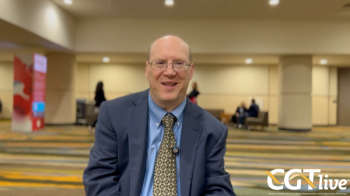
Liposomes a Workable Delivery System for E1A Gene Therapy
NEW ORLEANS--After delivery with a cationic liposome complex, the tumor-suppressor gene E1A was expressed by cells in many places in the body, Naoto Ueno, MD, of the M.D. Anderson Cancer Center, reported at the 89th annual meeting of the American Association for Cancer Research (AACR).
NEW ORLEANS--After delivery with a cationic liposome complex, the tumor-suppressor gene E1A was expressed by cells in many places in the body, Naoto Ueno, MD, of the M.D. Anderson Cancer Center, reported at the 89th annual meeting of the American Association for Cancer Research (AACR).
Mien-Chie Hung, PhD, interim deputy chairman of the Department of Tumor Biology at M.D. Anderson, was one of the first to identify the HER-2/neu cancer gene. Dr. Hung found that the E1A gene has an anticancer effect by reversing overexpression of the HER-2/neu gene, which is overexpressed in 20% to 30% of human breast and ovarian cancers. These tumors tend to metastasize and are resistant to chemotherapy, leading to lower survival rates among patients with HER-2/neu overexpression.
Because of the link between more aggressive tumors and HER-2/neu expression, Dr. Ueno said, scientists have wondered whether HER-2/neu expression could be halted and whether doing so would improve a patients prognosis.
The trial reported by Dr. Ueno was led by Gabriel Hortobagyi, MD, principal investigator and chairman of the Department of Breast Medical Oncology, and co-PIs Gabriel Lopez-Berestein, MD, and Dr. Hung, along with their colleagues at M.D. Anderson, University of Pittsburgh, and Targeted Genetics, Seattle.
Weekly Injections to 12 Patients
The investigators bound E1A to a cationic liposome and gave weekly injections of these altered liposomes to six breast cancer patients and six ovarian cancer patients, all of whom had failed standard therapy and were considered terminal. The injections were made into either the thoracic or peritoneal cavity. The researchers chose to test a liposome delivery system because it is less immunogenic and is biodegradable.
Because the current trial was a phase I study, the main objectives were to determine safety and an appropriate dose. The researchers found that patients on the highest dose, 7.2 mg/m2, had fairly severe nausea and vomiting and discomfort at the injection site. Patients taking 1.8 or 3.6 mg/m2 also had similar symptoms, but their symptoms were mild and could be controlled.
The researchers did gather some preliminary data on effectiveness in three patients. "At M.D. Anderson, we have detected E1A in both cancer and non-cancer cells by immunohistochemical staining in all three patients," Dr. Ueno said. HER-2/neu gene expression appeared to decline in all three patients.
They also analyzed various tissues of one patient by reverse transcriptase-polymerase chain reaction (RT-PCR), which revealed that E1A was being expressed in several organs, although not in brain, bone marrow, or ovary.
"We concluded from this that the E1A gene can be delivered to cancer cells by using this cationic gene delivery system," Dr. Ueno said. "We did observe the down-regulation of HER-2/neu after delivering the E1A gene, and we identified the right dosage." On the basis of these results, the researchers plan to proceed with a phase II trial in ovarian cancer patients.
When asked to compare E1A gene therapy with monoclonal antibody against HER-2/neu (see article page 1), Dr. Ueno said that both approaches seem like good ones now, and only further experimentation will tell which will be best. "The most important thing is that we explore many options," he said.
After his talk, Dr. Ueno, instructor, Department of Blood and Marrow Transplantation, and a PhD student, received an AACR-Glaxo-Wellcome Oncology Clinical Research Scholar award.
Newsletter
Stay at the forefront of cutting-edge science with CGT—your direct line to expert insights, breakthrough data, and real-time coverage of the latest advancements in cell and gene therapy.

















































